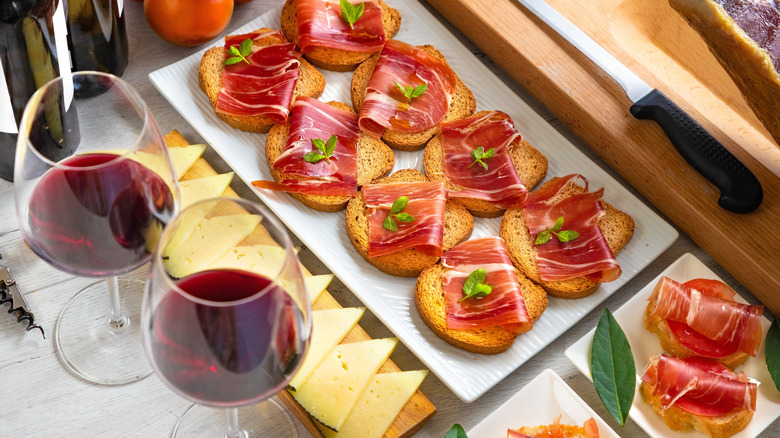Rick Steves' Genius Trick To Getting The Most Out Of Local Cuisine For Less
For travel expert and television host Rick Steves, eating the local cuisine is one of the greatest things about traveling in Europe. Whether you're an adventurous eater sampling some of the continent's more offbeat delicacies, or simply enjoying an evening of fine dining at a restaurant in Paris, the local food of Europe is not to be missed. But how can you get the most out of local cuisine without spending a fortune? Steves has a genius trick that will get you the most bang for your buck while also getting a full flavor experience.
"Whenever possible, I order family style so I can eat my way through more of the menu," Steves wrote for USA Today. "Sometimes, rather than getting two main courses, my travel partner and I share a little buffet of appetizers or first courses — they're filling, less expensive, and more typically local than entrees." This is one of Steves' top tier travel tips. Not only can ordering a slew of appetizers save you money, but it allows you to try more of the local cuisine than you would have by ordering a standard meal.
While you can easily order smaller plates in countries across Europe, there are some countries that have these small eats more embedded into the culture. A lot of the Mediterranean countries, such as Spain, France, Italy, and Greece, make it very easy for travelers to eat the way Steves is proposing. Let's dive into that.
Tapas, mezedes, and antipasti
Another plus of splitting your dinner into numerous small plates is that it takes a lot of the pressure off of choosing items from a menu. As Steves explains on his website, "One of the best examples of this is in Spain. Every town tempts you with tapas bars, where you belly up to the bar and just point at appetizers you'd like to try." Tapas bars will typically have a very wide selection of offerings, including Iberico ham, local olives, sausage, numerous types of fish, and assorted vegetables. Plates are cheap, costing between €2 to €4 apiece (just be careful, as many of these can add up).
You can find similar traditions and prices in Greece and Italy. Called mezedes (or meze) and antipasti respectively, you can find a vast amount of eating options regardless of where you are in the two countries. In Greece, expect things like fried local cheeses, plenty of seafood, olives, pickled vegetables, stuffed grape leaves, and lots of dipping sauces. For Italy, cured meats, olives, cheeses, fried polenta, bean salad, and grilled seafood are the name of the game.
You can still put together smaller plates in other countries. Steves recommends assembling your own special picnic of small items when visiting France. He's also a big fan of Denmark's open-faced sandwiches, a pot of fondue in Switzerland, and sausages and pretzels in Germany. All told, no matter where in Europe you go, a little bravery and creativity will have you eating like a local without spending too much money.

